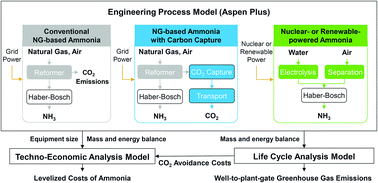科学者たちは、アンモニア生産をより持続可能なものにする方法を評価しています。 Scientists evaluate how to make ammonia production more sustainable.
2022-08-04 アルゴンヌ国立研究所(ANL)
Greenhouse gases, Regulated Emissions, and Energy use in Technologies (GREET®) モデルを使用して、様々なエネルギー源からアンモニアを生産する際の環境への影響を推定しました。次に、技術経済モデルを用いて、アンモニアをより持続的に生産するための2つの異なる方法のコストを検討しました。
1つ目の方法は、発生した炭素の一定割合を捕捉し、地層に貯蔵することで炭素放出をある程度回避する方法です。この技術では、アンモニアの生産にかかる総コストが約20%増加するだけなので、比較的低コストで実施することができる。
もうひとつの「ほぼゼロ・カーボン」技術は、水を電気分解して水素を製造し、その水素を窒素と結合させてアンモニアを製造する方法である。再生可能エネルギーや原子力を使って水を電気分解すれば、ほとんど炭素の影響を受けずにアンモニアを生産することができる。
<関連情報>
- https://www.anl.gov/article/argonne-researchers-develop-new-way-to-calculate-environmental-impact-of-ammonia-production
- https://pubs.rsc.org/en/content/articlelanding/2022/gc/d2gc00843b
従来型、炭素固定型、原子力、再生可能エネルギーによるアンモニア生産など、さまざまなアンモニア生産パスウェイの技術経済的性能とライフサイクル温室効果ガス排出量 Techno-economic performances and life cycle greenhouse gas emissions of various ammonia production pathways including conventional, carbon-capturing, nuclear-powered, and renewable production
Kyuha Lee, Xinyu Liu, Pradeep Vyawahare, Pingping Sun, Amgad Elgowainy and Michael Wang
Green Chemistry Published:13 May 2022
DOI:https://doi.org/10.1039/D2GC00843B
Abstract
Ammonia (NH3) is conventionally produced using fossil natural gas (NG) for hydrogen production through steam reformation and synthesis in the Haber–Bosch (HB) process. The global conventional ammonia production contributes more than 420 million tons of CO2 emissions annually. In this work, we investigated the techno-economics and well-to-plant-gate (WTG) greenhouse gas (GHG) emissions of conventional NG-based, carbon-capturing, nuclear-powered, and renewable ammonia production by developing an engineering process model for each. Carbon-capturing ammonia production refers to the NG-based ammonia production while capturing CO2 and transporting it via pipelines for storage or utilization. Nuclear-powered and renewable ammonia production represents an alternative ammonia production through water electrolysis, air separation, and the HB process using carbon-free energy sources. Nuclear and renewable energy sources are assumed to be used for nuclear-powered and renewable ammonia production, respectively. Sensitivity analyses are performed for CO2 pipeline transport distances, potential carbon capture tax credits, and clean H2 production cost. Carbon-capturing ammonia production reduces WTG GHG emissions by 55–70% compared to conventional NG-based ammonia production methods. Nuclear-powered and renewable ammonia production almost eliminate GHG emissions since energy supply is either zero carbon or near-zero carbon. However, when $4.16–4.83 per kg is the cost assumed for clean H2 production using state-of-the-art electrolysis technologies, the levelized costs of nuclear-powered and renewable ammonia are calculated to be $0.92–1.06 per kg NH3, which are approximately four times higher than the conventional NG-based ammonia production cost. The cost of CO2 emission avoidance is estimated in the range of $266–318 per metric ton of CO2 for nuclear-powered and renewable ammonia production. The clean H2 production cost is the major contributor to the levelized costs of nuclear-powered and renewable ammonia production. A lower production cost, near $1 per kg H2, for clean H2 is required for nuclear-powered and renewable ammonia production to be cost-competitive with conventional NG-based ammonia production.



